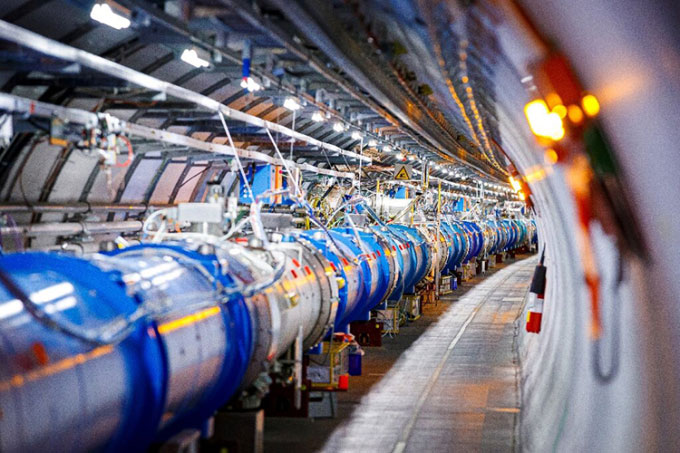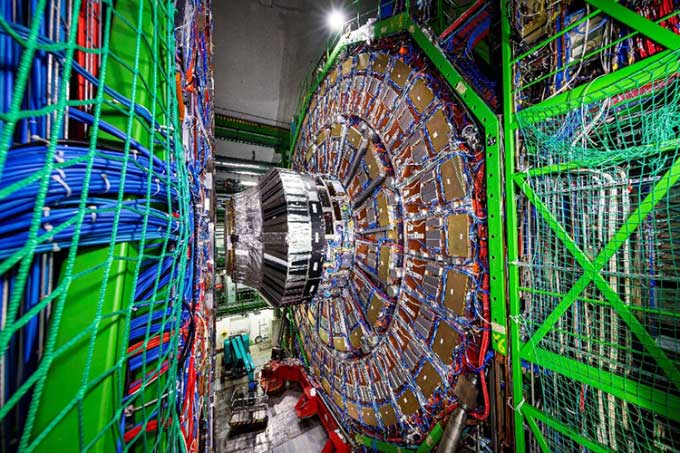Large particle accelerator is about to reach unprecedented energy levels
In a press conference last week, the European Organization for Nuclear Research (CERN) said the Large Hadron Collider (LHC) is preparing for its third run, lasting almost four years, with a speed of nearly four years. record energy of 13.6 trillion electronvolts (eV).

The Large Hadron Collider beneath the Swiss-French border.
It would send two beams of protons - particles in the nucleus of an atom - in opposite directions, at nearly the speed of light, around a 27-kilometer-long circular tube buried 100 meters inside. under the Swiss-French border.
The results of the collisions will be recorded and analyzed by thousands of scientists as part of a series of experiments, including ATLAS, CMS, ALICE and LHCb, to enhance dark matter exploration. , dark energy, and uncover other fundamental mysteries of the universe.
"We aim to generate 1.6 billion proton-proton collisions per second," Mike Lamont, CERN's head of accelerators and technology, told AFP.
At this point, the surrounding proton beam will be narrowed to less than 10 microns to increase the collision speed. For comparison, a human hair is about 70 microns thick. The new energy speed will allow CERN to further investigate the Higgs boson - a type of elementary particle in the standard model of physics that was first detected by the LHC on July 4, 2012.
CERN Director General Fabiola Gianotti, who first announced the discovery of the Higgs boson a decade ago, stressed that the particle is involved in some of the most profound open questions in fundamental physics today.

The new LHC will return to trial operation from April 2022 after a three-year pause for upgrades.
Compared with the first run when the LHC detected the Higgs, the new run will have 20 times more collisions. "This is a significant increase, paving the way for new discoveries," Lamont said.
Joachim Mnich, CERN's head of research and computing, adds that much remains to be learned about bosons.
Past experiments have determined the mass of the Higgs boson, but Gian Giudice, head of CERN's theoretical physics department, says observing the particles is only part of the job.
"Particle physics is not simply about answering the how, our goal is to understand why," added Giudice.
After this third run, the LHC will take a short break before returning to service in 2029 with a new name of the High Brightness LHC Accelerator, increasing the number of detectable events to humans. No. 10.
In addition, the scientists are planning to develop a new machine called the Future Circle Accelerator - a 100 km long circular pipe with a huge energy level of up to 100 trillion eV.
- The LHC accelerator will operate at the highest energy before
- In 2012, improving the energy of LHC to reach the design
- China wants to build a particle accelerator twice as large as the LHC
- China built the world's largest particle accelerator
- How will a large particle accelerator decipher the mystery of the universe?
- First collision between lead ion particles in LHC
- Can this Chinese super machine
- Unjust solution for large particle accelerators
- Visit the biggest machine in human history
- Large particle accelerator stops working due to mating bite
- Atom smasher creates new material
- Discover the idea of building a particle accelerator on the Moon
 Norway built the world's tallest wooden tower
Norway built the world's tallest wooden tower Kremlin
Kremlin Ashurbanipal: The oldest royal library in the world
Ashurbanipal: The oldest royal library in the world Decoding the thousand-year construction of Qin Shihuang shocked the world
Decoding the thousand-year construction of Qin Shihuang shocked the world The first train to transport the most expensive material on the planet
The first train to transport the most expensive material on the planet  CERN and its 70-year journey to discover the mysteries of the universe and science
CERN and its 70-year journey to discover the mysteries of the universe and science  CERN's large particle accelerator detects 3 new subatomic particles
CERN's large particle accelerator detects 3 new subatomic particles  Will find the
Will find the  CERN successfully simulated the Big Bang cosmic explosion
CERN successfully simulated the Big Bang cosmic explosion  Unjust solution for large particle accelerators
Unjust solution for large particle accelerators 